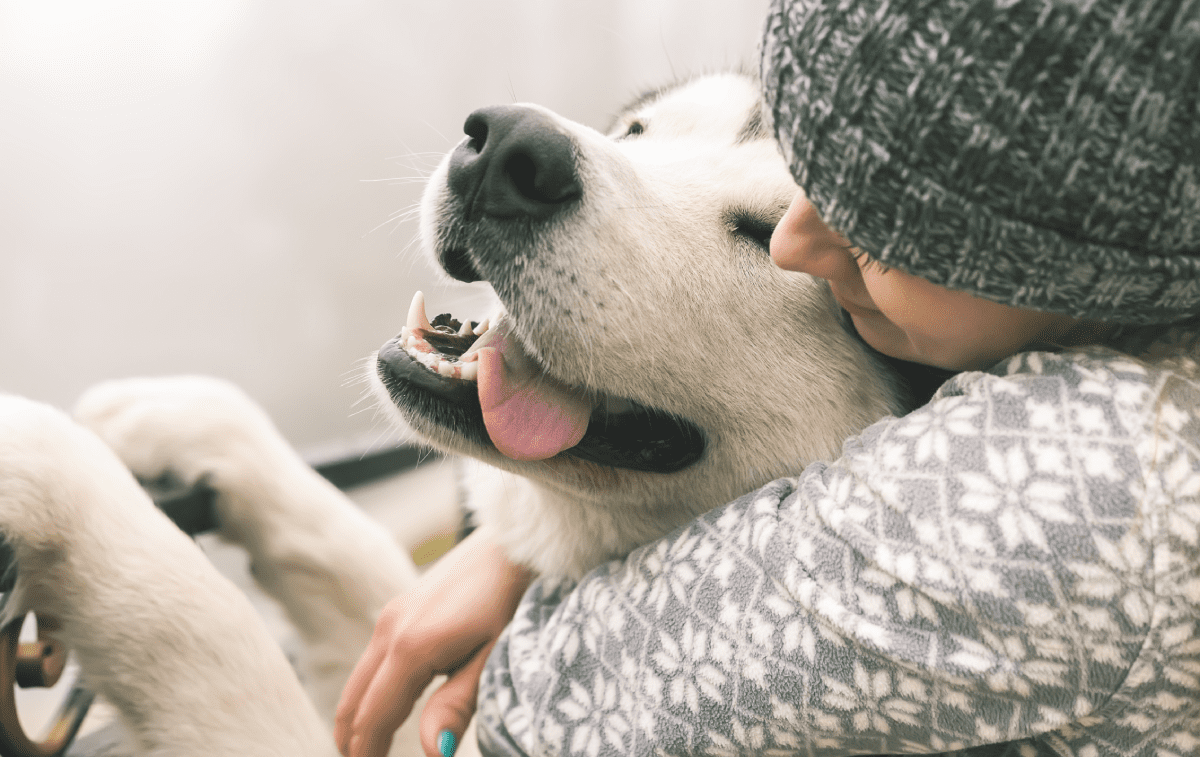Do you have a deaf dog? Here’s how you can support them
The last full week of every September is Deaf Dog Awareness Week. This year, it falls between September 24th and 30th, 2023. This occasion gives us an opportunity to learn about these special companions that take up a beloved place in so many hearts.
If you know or suspect your dog may be deaf or have hearing loss, you likely have many questions. Let’s discuss the causes of deafness in dogs, key identifiers of hearing loss, and why deaf dogs are some of the most wonderful pets in the world.

What Causes Deafness in Dogs?
Deafness in dogs can be attributed to various factors, mirroring some of the causes seen in humans. In most cases, deafness is hereditary for dogs and is often associated with specific coat patterns. Piebald and Merle pattern coats show a higher prevalence of deafness. The gene that causes Merle or Piebald coats affects eye color and skin pigment, usually presenting as mottled white patches of fur and blue eyes. Unpigmented skin in the inner ear can lead to nerve-ending atrophy and subsequent deafness in puppies during their early weeks of life.
There are other factors that can lead to deafness in dogs. Injuries to the ear, tumors, and aging can all cause a dog to become deaf. Temporary hearing loss in dogs is also possible, and common causes include ear infections or excess wax buildup in the ear canal. Some breeds are more susceptible to wax buildup than others. Dalmations, Boxers, and Bull Terriers have narrower ear canals, which can result in excess ear wax.
For other breeds, like Poodles and Cocker Spaniels, wax builds up due to an abundance of fur inside their ears. Additionally, dogs with floppy ears can be at risk if they swim frequently. Breeds such as Labradors, Golden Retrievers, and Newfoundlands can be affected by temporary deafness for these reasons.
Challenges for Deaf Dogs

Dogs who can hear rely on their hearing ability to safely maneuver and interact with their environment. When training a dog, verbal commands are the most common tools owners use. With a deaf dog, of course, these training methods must be altered, and the dog must rely on other senses to be safe.
This poses a significant challenge for deaf dogs when in an open environment. With this in mind, a deaf dog’s owner should never allow them to roam outside freely. Since a dog with deafness cannot hear traffic, other animals, or humans, it is not safe for them to be off-leash.
Some deaf dogs can become easily startled by other pets or people approaching them. Fortunately, this problem is often mitigated by tapping your foot on the ground near your deaf dog to alert them to your presence. Many dogs with deafness can feel vibrations on the floor as something approaches them.
This is especially important for deaf dog owners with children. You will want to teach your children how to carefully and respectfully approach a dog with deafness to avoid any reactivity. In most cases, a deaf dog will become accustomed to the subtle cues of someone getting close to them.
Signs Your Dog May Have Deafness
Deafness is considered a disability in dogs, but it can go unnoticed if the deaf dog is otherwise healthy. It can be hard to determine deafness in puppies due to their high energy and distractibility. However, a deaf puppy will not react to squeaky toys or more exciting tones of voice.
If an older dog has hearing loss, it may be difficult to tell at first. Fortunately, there are common behaviors and signs a dog may exhibit if they are experiencing hearing loss. Here are some typical signs of dog hearing loss, provided by the American Kennel Club:
- Excessive barking
- Tilting or shaking their head frequently
- Sudden unresponsiveness to sounds such as a knock on the door or filling their food bowl
- Ignoring verbal commands
If your dog is becoming less responsive to your calls or is no longer reacting to familiar sounds, it’s essential to seek a professional veterinary assessment. Your veterinarian can examine your dog’s ears to identify blockages, wax build-up, injuries, or infections that may be affecting their hearing.
Benefits of Owning a Deaf Dog

Although deaf dogs will experience more unique challenges, there are several wonderful benefits to owning a deaf dog! Due to their lack of hearing, dogs with deafness are not affected by noises that commonly trigger dogs who can hear. Fireworks, thunderstorms, and vacuum cleaners, some of the most common fears for dogs, do not affect deaf dogs. They can usually sleep peacefully through these triggers.
Many owners of deaf dogs report that training was an easier process. While you may think that training a deaf dog may be more difficult, dogs can learn commands fairly quickly through hand signaling and other methods. Positive reinforcement when the dog performs a hand-signaled command is essential, and dogs can easily learn non-verbal cues when treats are involved.
Deaf dogs are also more likely to enjoy cuddling up with their human family members. Because they cannot hear, they are drawn to their owners and need proximity to feel safe and know where their family is.
We Love Deaf Dogs
At Longwood Veterinary Center, we love deaf dogs and understand the unique challenges and benefits of owning a pet with deafness. If you know or suspect your dog may be deaf or experiencing hearing loss, contact our clinic. We can perform assessments to determine the status of your dog’s hearing and can recommend training methods and other modifications to help them live their best life.
